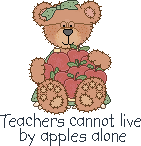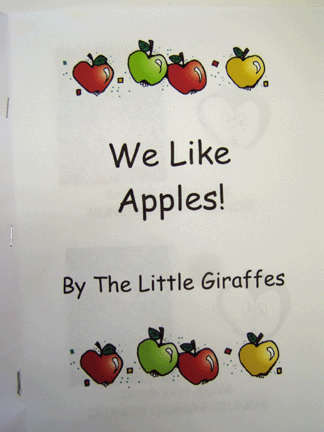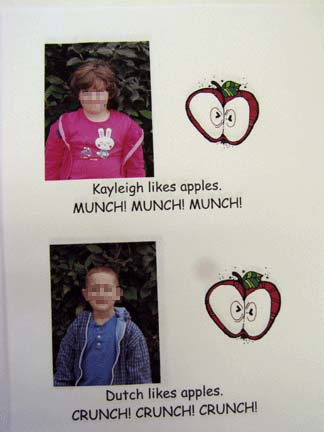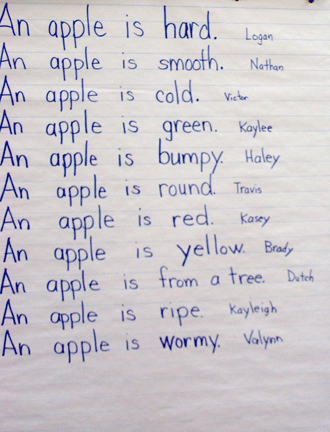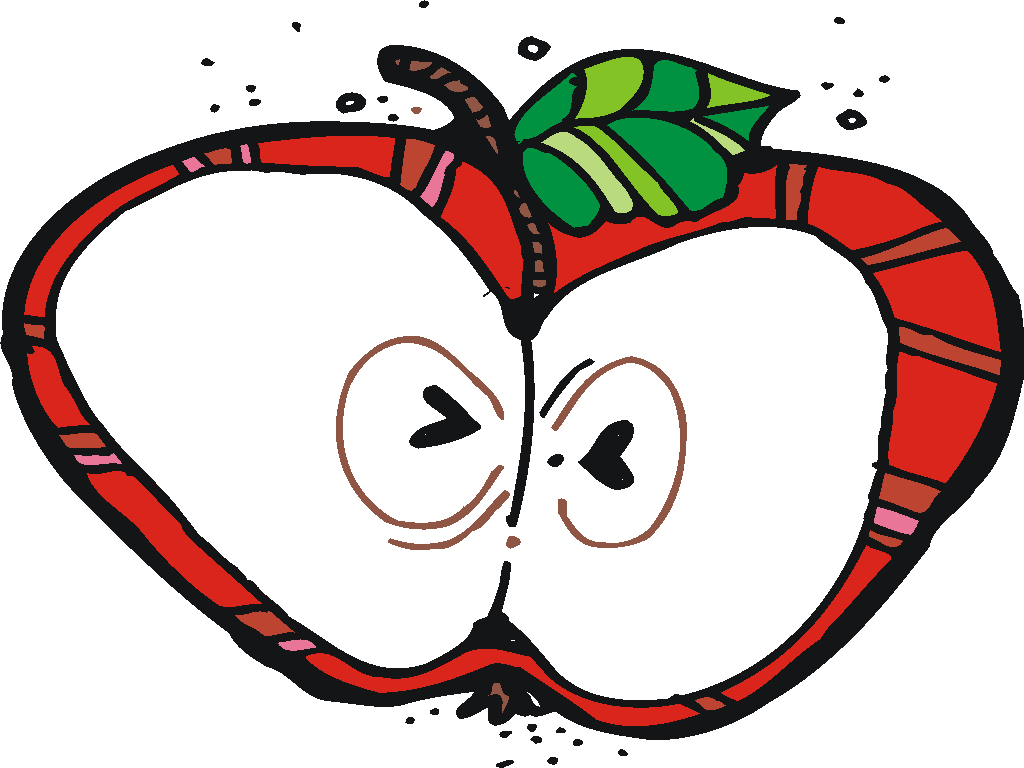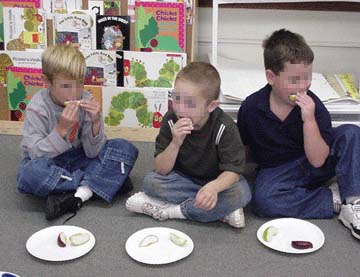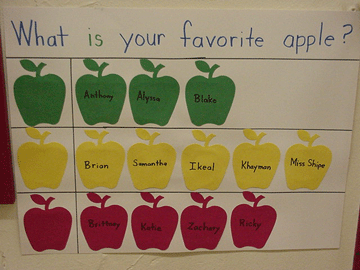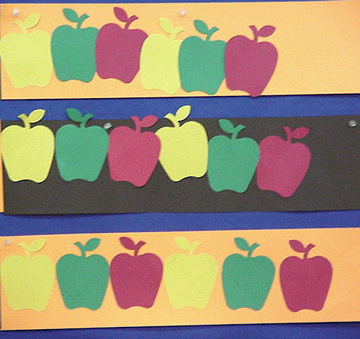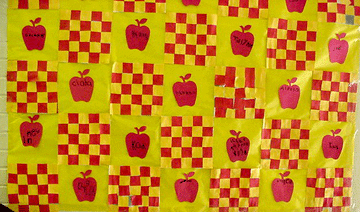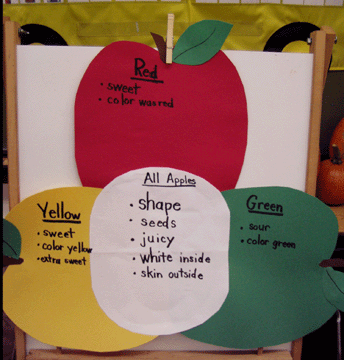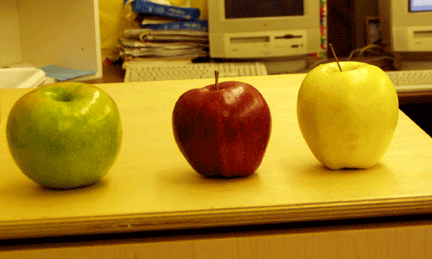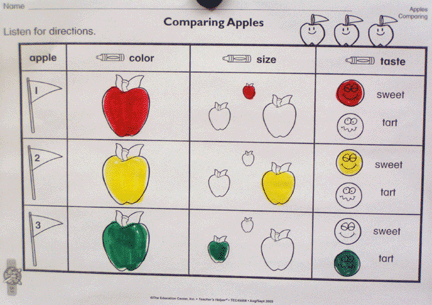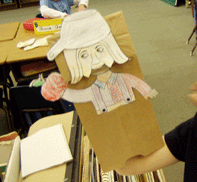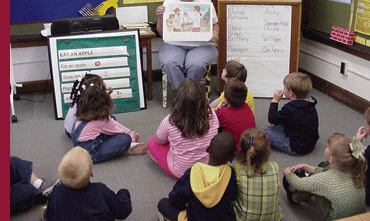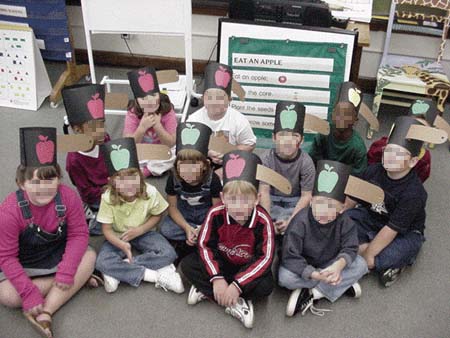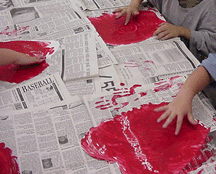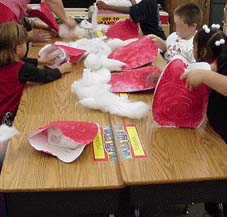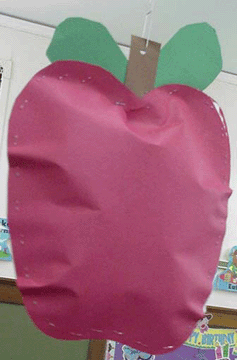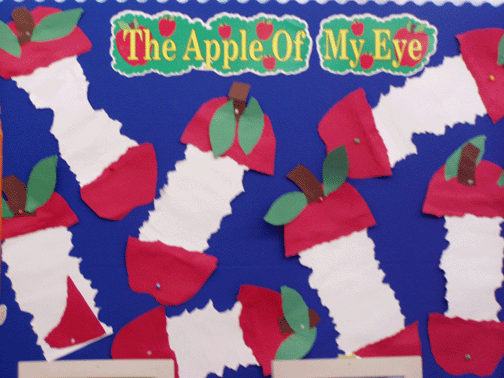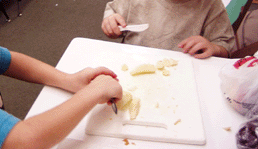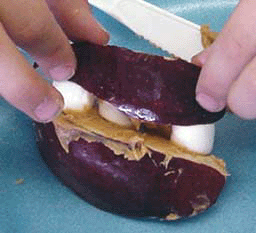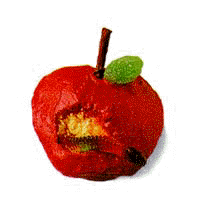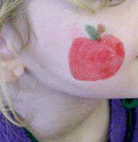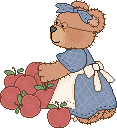| Poems | |
|
Five Red Apples |
Grandpa’s Farm |
|
Apples
|
Do You Know the Apple Man?
|
| Literature | |
|
An Apple a Day Apple Fractions by Jerry Pallotta |
|
| Literacy | |
|
Crunchy Munchy Class Book
This idea was posted by Kerry on the
Kinderkorner webring. Use an adaptation of this
poem:
______________ likes apples. |
We Have Apples Up on Top Class Book
|
|
I used the poem above to make a class book. Part of the poem appears beneath each child's photo. |
|
|
Rotten Apple Game
|
Predictable Chart
After observing and touching a green, yellow and red apple of varying sizes, each child contributed a descriptive word to a predictable chart about apples. We reread the chart for several days.
|
|
Apple Bingo
|
|
| The Story of the Little Red House | |
|
There was once upon a time a
little boy named John who was tired of all his toys and tired of all
his picture books and tired of all his play. |
|
|
Apple Poem
to supplement
The Little Red House |
|
| Math | |
|
Taste test red, yellow and green apples. Then make a graph of the class favorite.
|
|
|
Make apple patterns (AB or ABC) by gluing apples to a 4"X18" inch strip of construction paper. These could be made into a headband.
|
Make an Apple Quilt by centering apple cutouts on a background of squares in an AB pattern. |
|
Put an apple on one side of a balance scale and other objects (toy cars, glue bottles, scissors, etc.) on the other side to determine how many of each object it takes to balance the apple.
|
Which is heavier--an apple or a toy car?
Which is lighter--an apple or a wood block? |
|
Use paper apples
and an apple basket or tree workmat as a basis for patterning,
counting, estimation, and story problems. |
Estimate the
number of apple seeds in one or two apples. Count the seeds and
compare which has more, less, the same. |
|
Sort apples by
discussing likenesses/differences between apples. |
Graph favorite
apple product---apple, applesauce, apple pie, cider. |
|
Subtract real
apples or apple cutouts using a counting rhyme (above), apple
cutouts, tree workmat. |
Practice counting,
using Grandpa’s Farm rhyme (listed above). |
|
Cut apples into
pieces to introduce fractions. Use the book, Apple Fractions by
Jerry Pallotta,
as an introduction to this activity. |
Use yarn strips
cut by students to estimate the circumference of an apple. Tape
strings on a chart labeled Too Long, Too short, Just Right. |
| Science | |
|
Using apples brought from home, compare ways they are alike and different.
Similarities: All
apples grow on trees, have seeds inside, can be eaten, have a
relatively smooth skin, and have a hidden star inside if cut
properly. Differences: They
are not all the same size, shape or color, do not taste the same and
do not have the same texture. |
Use apple shapes to compare red, yellow and green apples (similar to a Venn diagram).
|
|
Keep a record (photos or drawings) of what an apple tree looks like during each season of the year. Reinforce this with the book, The Seasons of Arnold's Apple Tree by Gail Gibbons.
|
Predict if an apple will float or sink. Check this out with a real apple. Will other fruits and/or vegetables float or sink? |
|
We observed the color, size and taste of three different colors of apples to complete the paper seent to the right.
|
|
|
Sequence apple growth from seed to apple. This website has a "From Seed to Apple" flap book to make. The site is no longer available but it can be found at this link at archive.org.
|
Oxidation experiment: Cut an apple in half. Expose both halves to the air. Pour lemon juice on one half. Watch for changes. Which apple turns brown? Why? What does the lemon juice do? Draw what happens in a science journal.
|
| Centers | |
|
Apple balance
scale activity (described above in math). |
Make apple patterns (described above in math). |
|
Assemble an apple
puzzle (created by cutting apart a large apple) |
Make an apple necklace by cutting out apples, hole punching the top and stringing on yarn. |
|
Match colored apples to color words. |
Match lower case letter worms to capital letter apples.
|
|
Put numbers on baskets and students count paper apples and put the correct amount in each basket.
|
Glue alphabits cereal on an Aa written on an apple cutout. |
| Social Studies | |
|
Discuss how apples
are transported from the orchard to the supermarket. |
Take a field trip to an apple orchard and/or supermarket. |
|
Read some Johnny Appleseed books, discussing folk legends or using map skills to plot his travels. Make a Johnny Appleseed puppet. The pattern can be found here: http://home.att.net/%7Eelteach/appleseed.html
|
|
| Health | |
|
Where are apples
located on the food pyramid? |
Discuss importance of fruit in daily diet. Name some other fruits.
|
| Art | |
|
Make Johnny Appleseed hats, a "pot" students wear on their heads. Cut 5 inch strips of black paper to fit the heads. Glue on an Ellison punched apple. The handle is brown paper 3"x9" with one rounded end. Fold the straight end back and glue to the black cylinder. I use an apple hole punch to make a tiny apple a the curved end. |
Fingerpaint two apples and staple bottom edges when dry. |
|
Stuff with newspaper or filling. |
Staple closed and add a stem and leaves. This apple was not fingerpainted--just stapled and stuffed.
|
|
Large Apple Cores Make an apple core by tearing the edges of a white rectangle for the core. Then cut the top and bottom of the apple from red and tear the edges to look like bites. Add a stem and leaf.
|
|
|
Thumbprint Apple Art and Poem Make an apple tree and have the children use thumbprints to make apples. Attach this poem:
|
Handprint Apple Tree Apples are made by coloring an apple, then adding tissue paper squares to the top. Finally, brush a glue/ water solution over all. Trace a green handprint for the leaf/stem and add this poem:
This little apple that you see here
|
| Food | |
|
Applesauce
|
Apple Smiles
|
|
Apple Pizza
Separate the package into 10
biscuits and then cut each biscuit in half. Each child is given half
a biscuit on a piece of wax paper.
|
Apple Cupcake Family Fun Magazine
1 cupcake red frosting 1 mini pretzel stick melted chocolate 1 green gumdrop leaf 1 gummy worm
Unwrap the cupcake and ice it with red frosting. Dip the pretzel stick in melted chocolate, allow it to harden, then insert it for the stem. Add the gumdrop leaf. Cut a small "bite" out of the cupcake and insert the worm (or just half the worm.
|
|
|
|
| Parental Involvement | |
|
Apple Fun Day
|
Apple Express
|
| Other Sources of Information | |
|
Apples Theme @A to Z Teacher Stuff The
Mailbox, Kindergarten, Aug 1995 |
|
